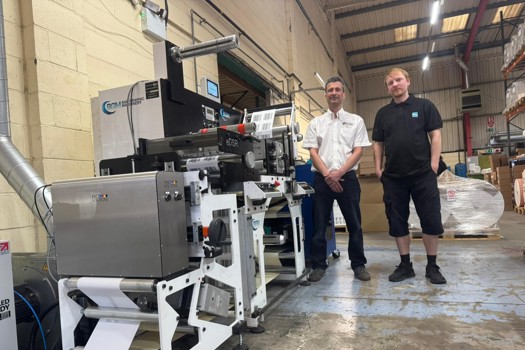What does it do?
Motioncutter is a very compact digital high-speed laser system that cuts, kiss-cuts, engraves and perforates sheetfed substrates. It can be used with paper or cartonboard for a range of applications that need intricate, short-run, dieless cutting. Every sheet can be personalised using the Namecut feature in the included software.
It was developed by Themediahouse, a German company specialising in personalised direct mail and packaging. When it couldn’t find a suitable commercial cutter, it commissioned its own.
When was it launched and what market is it aimed at?
It was first shown at North Print & Pack in May, although not in operation due to a lack of fume extraction facilities. The official launch was at November’s Dscoop Grand Prix event in Rome. According to Jörg Scheffler owner of Themediahouse: “We couldn’t pigeonhole the Motioncutter into one market application because of the crossover into different sectors for laser-cut packaging, direct mail, stationery, kiss-cutting adhesive labels, engraving creative artwork and also cutting and perforating wacky and difficult shapes.”
Shaun Stanley, the UK-based worldwide market development manager, adds: “The interest we’ve been getting has been for crossover work, from people who don’t want to just do packaging work but other things like artistic cutting and direct mail.”
How does it work?
Sheets of up to 580mm wide (nominally oversized B2 although the actual length is unlimited), can be fed either inline from a press or from a sheet feeder onto a conveyor system made of a special metal mesh belt (to minimise laser burn-through). Sensors locate the position of each sheet.
The sheets move continually through the working area while the 230W laser tracks them and produces the cuts, perforations, engravings and personalisation. Fumes are extracted through an encapsulated tubefan system, with fresh air supply from outside. A separation zone at the end of the conveyor removes waste sections before the finished items go onto a stacking system.
What’s the USP?
“There are many laser systems on the market, mainly linear machines which are quite labour intensive and run very slowly,” says Scheffler. “There are also specialised machines developed for packaging which have a much higher entry cost and also involve ongoing costs for consumables. Both types are limited in their applications whereas the Motioncutter can excel in all market applications.” The company also claims its Namecut personalisation software is unique.
What front-end software is supplied?
Themediahouse has developed its own software, which it says is similar in use to a digital press front-end. File formats accepted include AI, PDF, EPS, DXF, PLT, TIFF, BMP, GIF and more. Cutting lines can be added as an extra layout in the main artwork file.
How productive is it?
Throughput depends on the length of the cuts. The conveyor runs at up to 40 metres per minute and the deflecting mirror of the laser runs at up to 6 metres per second. If there is a lot of etching and perforating the speed will be reduced. As there are no metal dies to produce and make ready, set-up is simple and every sheet size and pattern can be different, making one-offs economical. Personalisation is handled by merging a CSV file from a database or similar list.
How easy is it to use?
“Most people who have uploaded a file on a digital press will be able to use the motioncutter within a few hours,” says Scheffler. “Minor adjustments in the strength of the laser or the speed of the system have to be made dependent on varying substrates but once this is learned then settings can be saved and used again.”
What training and service support is on offer?
There’s two days training when the machine is installed, after which users are certified laser operators (CLOs). Remote online support is aided by a webcam system and remote diagnostics.
What is the sales target and how many installations have there been so far?
There are now two installations in Germany. Stanley says that several companies in the UK are planning installations. “We have targeted 10-20 machines in the first year with this rising to 20-50 in year two,” says Scheffler.
SPECIFICATIONS
Max sheet size 580mm with any length
Substrate thickness No particular limit, but thicker materials will cause the machine to run slower
Max speed 6,000sph or 40m/min, depending on cut lengths
Max cutting speed 6m/second
Accuracy +/- 0.2mm
Laser type 230W CO2 10.6 micron wavelength laser
Laser life Around 15,000 hours
Footprint 2.5x1.5m
Price Around £164,000
Contact Themediahouse 01993 844016 www.motioncutter.com
ALTERNATIVE
Highcon Euclid
Highcon’s Euclid is a B1-format ‘direct to pack’ cutting and creasing machine for folding cartons. It uses a combination of three powerful lasers for cutting and a UV-polymer extrusion system called DART to create creasing rules on a separate impression cylinder. Unlike the Motioncutter, the Euclid forms real creases similar to what you’ll get from metal dies.
Justifying the higher price, the Euclid is considerably larger and faster than the Motioncutter and you get press-style sheet feed and delivery. However, the polymer rules are fixed for the duration of the run, so while the cuts can be varied, the creases can’t. DART polymer extrusion and curing takes place on the Euclid and can take 20 minutes between jobs.
Max sheet size 760x1,060mm
Substrate thickness 0.3 to 0.6mm
Max speed Nominally 1,500sph depending on cut length, or 3,000sph with 760x470mm sheets
Laser type Three 400W CO2 lasers covering full width
Footprint 8.6x2.1m
Price £582,000
Contact Highcon 0972 8 9101705 www.highcon.net
CUSTOMER RATING
“There is a profitable market behind the three-side-trimmed jobs. The combination of digital printing and the processing of the Motioncutter has increased turnover and profitability immediately” 5/5
Peter Holtkamp Peter Holtkamp Printworks, Dortmund, Germany










